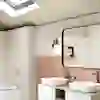Share:
The bathroom might be one of the smallest rooms in the home; however, it certainly doesn't have to feel that way. Turning up the brightness to just the right level can be just what's needed to open up space and create the look and feel you're aiming for. That said, no one wants to feel like they're under a spotlight at all times when you use your bathroom. So, how can you get it right? Read on to find out how to get light to the right parts of your bathroom and make optimal use of that space.
Maximising what comes in
At first glance, the bathroom can pose something of a challenge on the brightness front. On the one hand, privacy is a must. This is, after all, your private haven, so the windows have to offer a visual barrier between you and the outside world.But at the same time, you're likely dealing with a room where space is at a premium. It can feel like the physical constraints of the space are too restrictive to work with. That said, don't be disheartened: for giving the impression of greater space and breadth, natural light can be your best friend.
If you're lucky enough to be starting from scratch with window placement, it's worth getting creative about ways to maximise natural light while still giving yourself some privacy. For instance, you might want to consider multiple window panels set above head height. This can let in plenty of light, while keeping you out of view from the outside world. Alternatively, you might want to consider using semi-opaque glass blocks to create what is effectively a "wall of light". Likewise, a sloping roof could present the ideal opportunity for fitting a skylight.
Just remember that options for bathroom glazing go far beyond the standard single frosted window. It's definitely worth thinking carefully about how to maximise the level of light that enters the room.
Lighting for brightness
For many people, replacing an existing small bathroom window isn't going to be an option. There will also be those situations where there is no source of natural light at all - a second bathroom or an en-suite, for instance.
If you're relying entirely on artificial lighting, try and introduce an element of layering. One option might be several downlights to give just the right level of illumination around key 'working' areas -- the basin, for instance. Recessed lighting can be a great option in a bathroom precisely because the fittings themselves are so unobtrusive and take up very little space.
It may also be worth thinking about a layer of softer lighting. Examples might be LED backlights around the mirror panel or a concealed fitting within an alcove. Illuminating awkward nooks and crannies can be a fantastic way of putting those spaces to use. It also stops shadows from gathering, making the room feel far smaller than it really is.
This layered approach gives you an all-important element of control over the level of brightness in your bathroom. It's great for an easy-living bathroom, giving you the illumination you need to go about your daily tasks in a safe and accessible manner. At the same time, you can always rely on the ambient lighting in isolation for a softer, more relaxing ambience.
The bounce effect
So far, we've focused on the light sources both natural and artificial. Alongside this, there's a further important element to bathroom design that can really help you get the brightness right. Simply put, it's about making the most of what you've got.
From flooring through to furniture, the materials and finishes you introduce to your bathroom can go a long way to increasing the level of brightness in there. On the walls and floors, for instance, polished or high gloss tiles can help to bounce light around and significantly increase the feeling of light and space.
Especially when it comes to the walls, tiling isn't the only option. For instance, you might want to think about a series of simple gloss wall panels. Offering great value, these panels are quick to install and easy to maintain. The gloss finish reflects rather than absorbs light; the effect can set off a clean-lined, contemporary bathroom beautifully.
For the vanity and other items of furniture, your choice of colour can also influence how bright the room is going to feel. Especially if natural light is in abundance, then why not make the most of it by introducing a dramatic touch with darker hued finishes. Here, the concrete grey and indigo blue finish on iflo's Rhea units are worth close attention. Alternatively, if natural light is limited, furniture that features a high-gloss white finish such as Trapini or Galene can go a long way to bouncing and spreading it throughout the space.
The placing of mirrors can also help you make the most of what you've got when you think carefully about how it interacts with light sources. If possible, it's actually a good idea to work out where you are going to place your mirror before you add your artificial lights. Just be aware that lighting directly overhead can result in shadows under your nose and chin when using the mirror. So ideally, you'd have a ceiling fixture positioned just to the edge of your mirror, so the light makes contact with the surface and comes back towards your face in an indirect way. Pendants on either side of the mirror (or backlighting) can also help to reduce this shadowing.
Feeling inspired? Browse our ranges online or visit your local Showroom.
